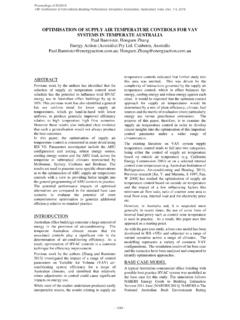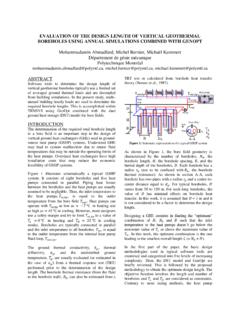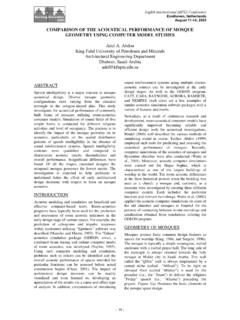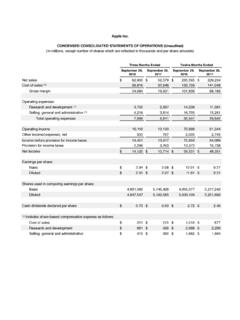Transcription of DETAILED MODELING OF SOLAR FLAT-PLATE …
1 Eleventh International IBPSA Conference Glasgow, Scotland July 27-30, 2009. 1 DETAILED MODELING OF SOLAR FLAT-PLATE COLLECTORS WITH DESIGN. 2 TOOL KOLEKTOR 3. 4 Tomas Matuska, Vladimir Zmrhal, and Juliane Metzger 5 Department of Environmental Engineering, Faculty of Mechanical Engineering 6 Czech Technical University in Prague, Prague, Czech Republic 7 E-mail: 8. 9. 10. design programs for SOLAR collector performance ABSTRACT MODELING considering the DETAILED geometrical and The mathematical model and design software tool physical parameters of collector . Several authors KOLEKTOR with user-friendly interface for evolved simplified analytical models considering the DETAILED MODELING of SOLAR thermal FLAT-PLATE temperature independent SOLAR collector overall heat collectors has been built and experimentally loss coefficient (linear dependence of efficiency), validated for different SOLAR thermal FLAT-PLATE neglecting the absorber temperature distribution or collector concepts.
2 The design tool is applicable temperature difference between absorber surface and especially for design and virtual prototyping of new heat transfer fluid. Such models are not comparable SOLAR FLAT-PLATE collectors resulting in efficiency curve with physical experiments and cannot predict the real determination, for parametric analyses to obtain performance behaviour and evaluate efficiency information on different parameters influencing the characteristics of SOLAR collectors. collector performance and especially for A theoretical model of SOLAR collector has been investigation of thermal performance of advanced introduced in TRNSYS Type 73 (TRNSYS, 2004).
3 SOLAR collectors (building integrated, evacuated but with simplified calculation of collector heat loss collectors, etc.). Examples of parametric analyses coefficient U insufficient to cover wide range of made for selected construction elements together parameters affecting the collector heat loss. A more with MODELING possibilities of the design tool theoretical model with several DETAILED input KOLEKTOR are presented in this paper. parameters and calculation of heat transfer INTRODUCTION coefficients in the individual parts of the collector (in air gaps, inside pipes, at outer surfaces) has been Computer MODELING of SOLAR thermal collectors is a evolved as Type 103 (Fraisse, 2003).
4 Principle approach for testing of new construction The design program CoDePro (Koo, 1999) for concepts and improvements in the development and energy performance calculation of SOLAR FLAT-PLATE design stage for developers and manufacturers. collectors has been developed with use of the Energy Virtual prototyping of SOLAR collectors can save the Equation Solver. It allows a very DETAILED investments into number of prototypes and foresee specification of collector geometrical and material the collector performance in advance. Analyses of parameters. It covers a large segment of SOLAR individual construction parts and detail parameters collectors (unglazed, single and double glazed) and impact on the collector performance are needed to evaluates also optical properties of the collector , make the decisions on efficient SOLAR collector incident angle modifier.
5 On the other hand, the concepts for given application, operation and climatic features of CoDePro analogous to TRNSYS Type conditions with respect to economic parameters of 103 do not allow energy performance MODELING of the construction. advanced SOLAR collectors, collectors integrated A mathematical model is always a simplification of into building envelope, evacuated FLAT-PLATE collectors reality to a certain extent. Too complex mathematical or SOLAR collector with glazing made of transparent models and numerical programs require a huge insulation structures. amount of computer time for calculations; too The presented model and design tool KOLEKTOR.
6 Simplified models do not take important influences of has been developed to overcome the drawbacks detail collector parameters into account and result in of previous models. KOLEKTOR is based on considerable uncertainty in calculation. To find a DETAILED calculation of heat transfer from the collector good compromise between simplicity of the model absorber to ambient and from the collector absorber and its accuracy is crucial for development of any to heat transfer fluid. The advantage of the design design and simulation tool. tool is its universality for wide SOLAR FLAT-PLATE Although the theory of FLAT-PLATE SOLAR collectors is collectors stock from evacuated to atmospheric, well established and can be found in basic literature separately installed or building integrated, covered (Goswami et al.)
7 , 1999; ISES, 2001; Duffie, with different types of glazing (single glazing or Beckman, 2006), there is a lack of user-friendly - 2289 - transparent insulation structures), operated with temperatures of main collector levels should be different heat transfer fluids, etc. known, but on the other side the temperature distribution in the collector is dependent on the heat MATHEMATICAL MODEL transfer coefficients. Therefore, the external energy The core of the design tool KOLEKTOR is a balance of absorber is solved in an iteration loop mathematical model of SOLAR FLAT-PLATE liquid starting from a first temperature estimate for each collector solving one-dimensional heat transfer main level based on given input temperature tin and balances.
8 The SOLAR collector is defined by means of ambient temperature ta. The external balance iteration main levels: glazing exterior surface (p1), glazing loop yields in overall collector heat loss coefficient interior surface (p2), absorber (abs), frame interior U [ ]. surface (z2) and frame exterior surface (z1). These levels are schematically outlined in Fig. 1. DETAILED geometrical and physical properties of individual parts of the SOLAR collector , climatic and operation parameters are the input parameters of the model. Basic outputs of the model are usable heat gain Qu [W], efficiency with respect to the reference collector area (gross area AG, aperture area Aa) and output heat transfer fluid temperature tout.
9 Figure 2 Schematic layout of external energy balance of absorber The internal energy balance of the absorber assesses the heat transfer from the absorber surface into heat transfer fluid provided by fin heat conduction, by heat conduction through the bond between absorber and pipes and by forced convection from pipe internal surface to fluid. Internal balance results in Figure 1 Main temperature levels in SOLAR collector determination of collector efficiency factor F' [-] and model collector heat removal factor FR on the basis of input parameters, operational and climatic conditions and The mathematical model of SOLAR collector consists of results from external balance.
10 Main outputs from external energy balance of absorber (heat transfer internal balance are output fluid temperature tout, from absorber surface to ambient environment) and mean heat transfer fluid temperature tm and internal energy balance of absorber (heat transfer particularly absorber temperature tabs, which governs from absorber surface into heat transfer fluid). The the calculations in the external balance. The internal model solves the energy balance of the SOLAR collector balance proceeds in its own iteration loop with under steady-state conditions according to principle respect to relative dependence between mean fluid Hottel-Whillier equation for usable heat power temperature tm and forced convection heat transfer Q u = Aa FR [ G U (t in t a )] (1) coefficients in absorber pipe register.
















